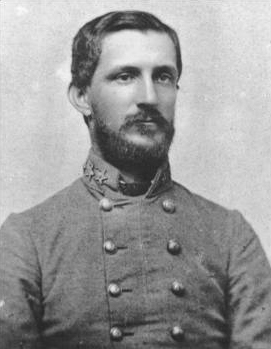
George Edward Pickett was a career United States Army officer who became a major general in the Confederate States Army during the American Civil War. He is best remembered for being one of the commanders at Pickett's Charge, the futile and bloody Confederate offensive on the third day of the Battle of Gettysburg that bears his name.

Robert Frederick Hoke was a Confederate major general during the American Civil War. He was present at one of the earliest battles, the Battle of Big Bethel, where he was commended for coolness and judgment. Wounded at Chancellorsville, he recovered in time for the defense of Petersburg and Richmond. His brigade distinguished itself at Cold Harbor, acknowledged by Grant as his most costly defeat. Hoke was later a businessman and railroad executive.
The Battle of Wyse Fork, also known as the Battle of Kinston, was fought in the Carolinas Campaign of the American Civil War, resulting in a Union Army victory.

The 26th North Carolina Infantry Regiment was an infantry regiment of the Confederate States Army during the American Civil War. The regiment was composed of ten companies that came from various counties across North Carolina and Virginia. It is famous for being the regiment with the largest number of casualties on either side during the war.

James Green Martin was a brigadier general in the Confederate States Army during the American Civil War.

Charles Adam Heckman (1822-1896) was a brigadier general in the Union Army during the American Civil War. He fought in many of the early battles in North Carolina and later served in the Army of the James during the siege of Petersburg.
Burnside's North Carolina Expedition was a series of engagements fought along the North Carolina Coast between February and June 1862. The expedition was part of Winfield Scott's overall Anaconda Plan, which aimed at closing blockade-running ports inside the Outer Banks. The amphibious operation was carried out primarily by New England and North Carolina troops under Brig. Gen. Ambrose E. Burnside and assisted by the North Atlantic Blockading Squadron under Captain Louis M. Goldsborough.

The 51st Regiment Massachusetts Volunteer Infantry was a regiment of infantry that served in the Union Army during the American Civil War. The regiment was assigned to Major General John G. Foster's Department of North Carolina, later designated as the XVIII Corps. While based in New Bern, North Carolina, the 51st Massachusetts took part in several expeditions involving numerous units from Foster's command and were engaged in the Battle of Kinston, the Battle of White Hall and the Battle of Goldsborough Bridge, among other engagements.

Lieutenant Augusto Rodríguez, was a Puerto Rican who served as an officer in the Union Army during the American Civil War. Rodríguez served in the defenses of Washington, D.C., and led his men in the Battles of Fredericksburg and Wyse Fork.
The 27th Massachusetts Volunteer Infantry was an infantry regiment recruited in Massachusetts for service in the American Civil War.

The Battle of New Bern was fought during the American Civil War from February 1–3, 1864. The battle resulted in the failure of Confederate forces trying to recapture the coastal town of New Bern which had been lost to the Union Army in 1862.

The 15th Connecticut Infantry Regiment was an infantry regiment that served in the Union Army during the American Civil War.

The 17th North Carolina Infantry Regiment was an infantry regiment that served in the Confederate States Army during the American Civil War. It served in North Carolina and Virginia.

The 17th Massachusetts was an infantry regiment that served in the Union Army during the American Civil War.
The 25th Regiment Massachusetts Volunteer Infantry was an infantry regiment that served in the Union Army during the American Civil War.

The 3rd Massachusetts Volunteer Militia Regiment was a peacetime regiment of infantry that was activated for federal service in the Union Army for two separate tours during the American Civil War. The regiment consisted of companies from Plymouth and Bristol Counties.

The 5th Regiment Massachusetts Volunteer Militia was a peacetime infantry regiment that was activated for federal service in the Union army for three separate tours during the American Civil War. In the years immediately preceding the war and during its first term of service, the regiment consisted primarily of companies from Essex County as well as Boston and Charlestown.
The 1st North Carolina Union Volunteer Infantry Regiment was a military unit of the Union Army during the American Civil War recruited from coastal counties in North Carolina. The Regiment was made up of Southern Unionists and deserters from the Confederate Army, and fought in several battles in North Carolina before being disbanded in the summer of 1865.
















